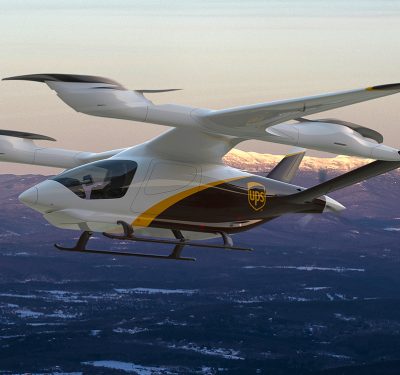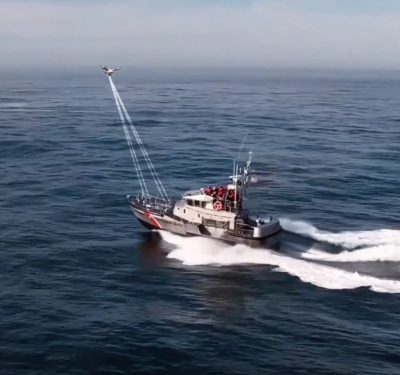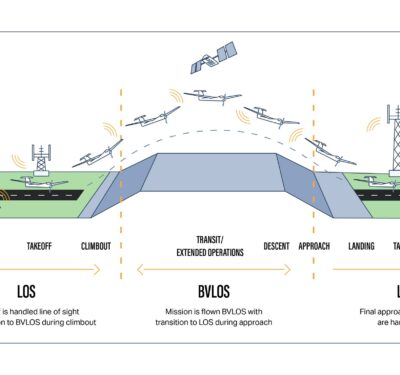This year’s theme, “Connected Skies, Connected Communities,” brought a focus on the importance of connectivity and integration in advanced aviation to benefit both urban and rural communities. Exciting developments on the regulatory front showed great promise for moving ahead with commercial BVLOS operations.

For the eighth consecutive year, the FAA and AUVSI co-sponsored the FAA Drone & AAM Symposium. Previously two separate events—the FAA Drone Symposium and AAM Summit—this year’s event was the first staging to combine both technologies and audiences. Inside Unmanned Systems was in Baltimore covering the event live.
FAA Part 108 Rulemaking Team Comments on Progress, Third-Party Service Providers
Of particular interest was a standing room only session with the cross-FAA team working on the eagerly awaited Part 108 rule for normalizing commercial BVLOS flights in the National Airspace, without visual observers. Though a work in progress, meaning that all comments were heavily underlined as provisional in nature and subject to change, the FAA’s eagerness to engage with industry partners showed advanced progress in the safety aspects of the forthcoming rule.
Jarrett Larrow, policy and rulemaking lead, FAA, said, “We have progressed quite rapidly over the past year. Also, a high note is reauthorization language that came in [from Congress] over the past couple months. Here we’ve got pretty clear direction, we know there’s a deadline in there, we know there was useful language on third party service approval. We continue to move forward and are hoping to get this on the street as quickly as possible.”
The third-party service provider approval is one example where the FAA is considering allowing industry partners to be licensed to provide UTM services, as in the case of the approvals for Wing and Zipline to provide commercial delivery BVLOS in the Dallas area, which was also announced during the symposium. In this system, the industry uses UTM to manage the airspace with rigorous FAA safety oversight.
The FAA’s executive director, rulemaking, Brandon Roberts emphasized the nascent state of the rule, but also the significant progress made. “When we’re in a rulemaking project, we’re in what’s known as our ex parte phase of rulemaking. We have to be cautious about what we say, because this is not a published proposal, and anything can change. We’re in an active review process. But we do want to share with you our general thinking from the safety side. We’re very excited about what we’ve been able to pull together collaboratively across the entire FAA on the safety piece.”
Larrow added, “We have been leaning into more of a shift to a corporate oversight structure here rather than individual certificates. I think there’s a clear recognition coming out of the FAA that individuals [being] responsible for these kinds of diverse types of operations isn’t the best, most effective way for us to regulate the variety of operations that we see and how to maintain safety through them. We have to think of some new approaches here. We are leaning pretty hard into regulating the corporations, the companies at a more holistic level.”
This approach of certifying organizations rather than individual operators will allow companies to have one blanket approval, at which point they may handle the safety training and onboarding of their individual operators, who will be certified as part of the overarching corporate certification.
Nick Matlock, the FAA’s aviation safety inspector, said, “We’re considering proposing for a potential operator looking to do BVLOS operations, to do that in one of two different ways. One would be in the form of an operational permit that you would apply for and receive from the FAA. And the second would be in the form of a certificate, an operational certificate that the FAA would issue to you. With the permit, it would have heavier regulatory restrictions on it. Things such as the unmanned aircraft may be a little bit lower in weight, you may have less aircraft associated with that permit. And the overall size and scope of the operation would look a little bit smaller. The benefit to that is there would be less FAA involvement associated with a permit. And so rather than an approval taking weeks, months, or even years, it may take days to get an approval.”
Detailing the certification route, Matlock added, “A certificated operation would look a little more traditional, like the FAA currently does certificated operations. You would see more FAA involvement, potentially a team of inspectors and a certificate management team, and they would guide you through the evaluation and validation process. And that may take a little bit longer of a period for approval.”
Matlock detailed eight potential categories of operations being considered, plus an additional other category, to maintain flexibility for future use cases. “Under permit,” Matlock detailed, “you would have individual categories for the type of operations you want to do, each individual category would also have its own individual operational restrictions. One category under a permit may be limited on weight and speed, and the number of aircraft that the operator can have as opposed to a different category of operation under a permit. The eight categories that we are considering proposing are package delivery, agriculture, aerial survey, demonstration, civic interest, flight testing, flight training, recreational and then the other category.”
A point strenuously underlined by all FAA speakers was the importance of collaboration with industry stakeholders through the comment and review process. When the draft rule and public comment period opens, the Agency will carefully review each comment and all feedback. They want to ensure they capture all the adequate use cases for industry and are very open to constructive conversations about making improvements, while absolutely solidifying the safety framework.

Navigating Compliance: Regulatory Solutions
uAvionix Chief Commercial Officer, Christian Ramsey, detailed the firm’s long history in providing avionics solutions across manned and unmanned aircraft, with an emphasis on recent developments in BVLOS for UAS. Ramsey traced uAvionix’s work dating back to the 2015 Pathfinder program, followed by adoption of the Part 107 Rule. “Ever since Part 107, we’ve been trying to figure out how to get to the next thing. And the next thing, of course, will be Part 108. But in the meantime, we’ve got BVLOS waivers, these waivers are bespoke, they’re specific to the UAS operation. They’re not broadly repeatable.”
“Recently, you’ve heard more about exemptions,” Ramsey explained. “The difference between a waiver and an exemption is that the exemptions are theoretically supposed to be a bit more repeatable. You’re not applying for specific waivers every single time, but you get the concept of your operation approved under an exemption. And then you can repeat that recipe. But really what we’re trying to move forward to is what’s in Part 108. We want it to be prescriptive, we want it to tell us the recipe for operations, mitigating risks and how you calculate your risk.”
Ramsey echoed the shift to organizational responsibility from individual operator responsibility as a positive likely change in Part 108. “The organization in terms of the parent company who wants to operate these things, [today] all the responsibility is on the operator. And the organization can’t take credit for the safety culture that they built. That’s not a part of what we have today. And that’s what we’re looking forward to under Part 108.”
In a fireside chat discussion under the same topic area of navigating compliance, the City of Tulsa and Tulsa Innovation Labs detailed their successful partnership and community engagement strategies. Justin Kitts, director of public affairs, Tulsa Innovation Labs (TIL), talked about the unique partnerships between TIL and Tulsa to enable widespread commercial UAS adoption. “We’ve seen significant momentum and progress in our community over the last several years. We’ve received $90 million over the last two years from the Build Back Better challenge, and a recent tech hub award from the US Economic Development Administration, all to invest in our drone economy.” Blake Ewing, chief of staff to the Mayor of Tulsa, outlined the city’s “incredibly fruitful partnerships with TIL that have culminated with the Mayor’s declaration that he wants to create Tulsa as the drone capital of the world.”
On the topic of civic engagement and broad partnerships, he added, “Something that occurred pretty quickly in those meetings is we focused on the larger regulatory questions, technology questions and feasibility questions. Once we started broadening the conversation, especially with local government folks at the table, the question started being about how you’re going to convince the public that this is an okay thing to have in our city. It’s been an important multi-level conversation, to start establishing our game plan for how we build that trust.” Beyond the regional technology and economic incubator, the work being done in and around Tulsa can provide lessons learned and valuable data gathering. This could lead to applying findings from the Tulsa initiative at the national and international level for implementing an ambitious drone program with public engagement and support.
UTM to Enable BVLOS
IUS contributor Dawn Zoldi moderated a panel focusing on the latest regulatory developments and technological breakthroughs shaping the landscape of UTM. In this session, the FAA, Zipline and Wing announced the first of its kind BVLOS approval for unobserved commercial operations in shared airspace. It was a further underlining of the innovations that can be unlocked with the third-party airspace service provider language in section 337 of the recent FAA Reauthorization by Congress.
Jessica Brightman, manager, implementation branch, safety & integration division, FAA, commented, “UTM is really required for scalability of BVLOS. Without it, we will not be able to allow the volume that I expect to see from demand, and also the variety of operations.”
Brightman detailed how the third-party service provider process is being conceived to work and has been kicked off with the letters of acceptance for Wing and Zipline. “We’ve created this process where we work with a champion operator, an automated data service provider, whether that be a supplemental data service provider or a UAS service supplier for UTM, such as strategic deconfliction.” Brightman continued, “They file a waiver or exemption request with the FAA. And when we review that request, with an application for the waiver petition for the exemption, we look at the safety risk that the automated data service provider or UTM service can mitigate. And we review that sort of separately and we review it and document it so that we can see that it can be scalable and repeatable.”
The level of focused interest, passionate engagement and regulatory progress across all the sessions drove home a palpable sense of AAM coming to life now. The moment where AAM powered by UTM through FAA partnering effectively with industry and the public is here today, and will be unleashing its full potential soon.






